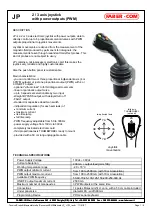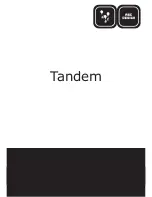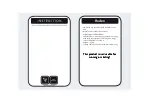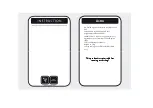
Page
7
Option 2:
Forward / Backward
The "Forward/Reverse" mode also offers the reverse driving function. This mode is well suited
for most applications. (Note: Make sure that your boat can go backwards. If the drive is
equipped with a flexible shaft, it can only move in one direction, the reversal of direction can
damage a flexible shaft.
2.
LiPo
Cells
:
The controller automatically calculates the number of LiPo cells. If automatic detection is
activated, the controller determines the number of cells on the basis of the battery voltage. A
battery with a voltage below 8.8 V is detected as 2S LiPo. A battery with a voltage of 8.8 V to
13.2 V is identified as 3S LiPo. If a battery is not fully charged when connected to the
controller, miscalculations may occur so that a 6S LiPo that is not fully charged is identified as
5S LiPo. As a result, the undervoltage protection function may not function properly. Therefore,
you must always plug in a fully charged battery. If you only use one LiPo battery at a time, we
recommend manual setting of the LiPo cell count.
3.
Undervoltage protection:
If you are using a LiPo battery, you must set a correct cut-off voltage for your battery
according to the discharge rate "C". The ESC constantly monitors the battery voltage.
The undervoltage protection is activated, the output power is significantly reduced if the
battery voltage drops below the programmed cut-off voltage.
A:
How is the cut-off voltage calculated? cut-off voltage = cut-off voltage per
cell x cell count. If the limit value is set to 3.2 V / cell, the undervoltage drop is triggered
at
9.6 V (3 x 3.2 V) with a 3S LiPo.
B:
After entering the undervoltage threshold: If the
protection is activated, half the power is output at the output.
This means that the output power is only 50% even at full throttle. The red LED then
flashes slowly at the same time. Please return your boat to land immediately and insert
another fully charged battery.
Warning! If you ignore the "Note" and continue to use
the battery, the battery will be irreparably damaged.
C:
If you use NIMH batteries: Because these cell types do not necessarily require an
undervoltage protection, you can deactivate the protection. If you notice a drop in power,
return your
rc-
boat immediately to the shore and insert another fully charged battery.
4.
Overtemperature protection:
This protection does not stop the motor if the temperature of the controller exceeds the set
value, but the output power is reduced to half (50%). The green LED flashes every time you
move the throttle lever to the neutral position.
The controller operates normally again as soon as it has cooled down to a temperature below
80
°
C.
5.
BEC voltage
Option 1: 6.0 V
For normal servos, not for HV servos, otherwise they cannot provide their full performance
Option 2: 7.4 V
For HV servos, do not use with normal servos, which could be destroyed by the higher voltage
6. S
tart mode / punch:
You can set the start mode in the ranges 1 (very soft) to 5 (very aggressive). Note that a
powerful battery is used in "Level 4" and "Level 5",so the tension doesn't drop. If the battery can
not deliver the high current the model jerks. You must then reduce the level of the start mode.
Operating Manual
RO-Control NAVY Pro Serie
s
No.8725
No.8726
Page
8
7. Timing / General Timing:
This function has three aspects:
•
The controller can be configured for operation with different motors. The default setting of
15 degrees is suitable for many motors, but special motors require different values. Set the
optimal timing level for your engine.
•
Fine-tune the output power of the motor. The higher the timing is set, the higher the engine
speed and power of the engine, but more electrical energy is consumed.
•
Optimum adjustment of the motor to the most efficient operation
8. Turbo acceleration
:
When the turbo acceleration is triggered, the controller immediately goes to the set value of the
turbo timing stage and thus provides greater power. This function can be used on longer straight
stretches on the water, outside curves
Note 1
:
•
For the additional acceleration you need another channel (channel 3 or 4), connect the
additional connection cable to the corresponding receiver output. The servo travel on this
channel must be set to at least 80%, use the normal setting of 100%.
•
With a pistol grip transmitter, channel 3 or 4 is usually implemented by a key, pressing the
key activates the turbo acceleration. With a normal transmitter, channel 3 or 4 is usually
implemented by a switch, and turbo acceleration is activated or deactivated by pressing a
switch.
•
If the general timing is set higher than the turbo timing (example: normal timing at 22.5
degrees and turbo timing at 15 degrees) the turbo acceleration has no effect. Therefore,
make sure that the turbo timing value is set higher than the normal timing value.
9.
Turbo Timing:
The value can be set between 0 and 26.25 degrees, the value becomes effective as soon as
the turbo acceleration is activated. When turbo acceleration is enabled, the ESC sets the
appropriate turbo timing after receiving a signal for turbo acceleration.
10.
PWM
frequency
:
Increasing the PWM frequency can cause the motor to run smoother, smoother and the noise
to decrease, but the regulator will heat up more. If the motor runs smoothly, we recommend
selecting the default setting (8 KHz).
Programming is carried out in four steps.
Activate programming mode → Determine parameters to be changed → Adjust
selected parameters → Exit programming mode
07.
Programming the controller
Operating Manual
RO-Control NAVY Pro Serie
s
No.8725
No.8726
Programming the ESC with your transmitter
































